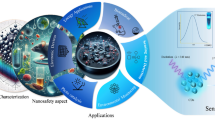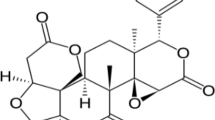Abstract
Methyl nicotinate (MN) is a representative and typical volatile organic marker of Mycobacterium tuberculosis, and the specific detection of MN in human breath facilitates non-invasive, rapid, and accurate epidemic screening of tuberculosis infection. Herein, we constructed a fluorescent assay consisted of CdTe quantum dots (QD) and cobalt-metalized tetrakis(4-carboxyphenyl) porphyrin (CoTCPP) nanosheets to determine methyl nicotinate (MN) in vapor samples. Red-emission QD (λex=370 nm, λem=658 nm) acts as signal switches whose fluorescence signals can be effectively quenched by CoTCPP nanosheets but restored in the presence of MN. The strategy relied on the distinct binding affinity of cobalt ion and MN. MN restored the fluorescence of QD quenched by CoTCPP in a concentration-dependent manner, which exhibited a well-linear relationship in the range 1–100 μM, and a limit of detection of 0.59 μM. The proposed platform showed sensitivity and selectivity to detect MN in vapor samples with satisfactory RSD below 3.33%. The method is cheap, simple, and relatively rapid (detected within 4 min), which suggests a potential in tuberculosis diagnosis in resource- and professional-lacked areas.
Graphical abstract






Similar content being viewed by others
References
Behr MA, Kaufmann E, Duffin J, Edelstein PH, Ramakrishnan L (2021) Latent tuberculosis: two centuries of confusion. Am J Respir Crit Care Med 204:142–148. https://doi.org/10.1164/rccm.202011-4239PP
Ayub A, Yale SH, Reed KD, Nasser RM, Gilbert SR (2004) Testing for latent tuberculosis. Clin Med Res 2:191–194. https://doi.org/10.3121/cmr.2.3.191
Kunst H (2006) Diagnosis of latent tuberculosis infection: the potential role of new technologies. Respir Med 100:2098–2106. https://doi.org/10.1016/j.rmed.2006.02.032
Ewer K, Deeks J, Alvarez L, Bryant S, Waller S, Andersen P, Monk P, Lalvani A (2003) Comparison of T-cell-based assay with tuberculin skin test for diagnosis of Mycobacterium tuberculosis infection in a school tuberculosis outbreak. Lancet 361:1168–1173. https://doi.org/10.1016/s0140-6736(03)12950-9
Richard Menzies BV (1992) Effect of bacille Calmette-Guérin vaccination on tuberculin reactivity. Am Rev Respir Dis 145:621–625. https://doi.org/10.1164/ajrccm/145.3.621
Morad K. Nakhleh RJ, A’laa Gharra, Anke Binder, Yoav Y. Broza, Mellissa Pascoe, Keertan Dheda, Haick H (2014) Detecting active pulmonary tuberculosis with a breath test using nanomaterial based sensors. Eur Respir J 43:1522-1525. https://doi.org/10.1183/09031936.00019114
Vishinkin R, Busool R, Mansour E, Fish F, Esmail A, Kumar P, Gharaa A, Cancilla JC, Torrecilla JS, Skenders G, Leja M, Dheda K, Singh S, Haick H (2021) Profiles of volatile biomarkers detect tuberculosis from skin. Adv Sci (Weinh) 8:e2100235. https://doi.org/10.1002/advs.202100235
Syhre M, Chambers ST (2008) The scent of Mycobacterium tuberculosis. Tuberculosis 88:317–323. https://doi.org/10.1016/j.tube.2008.01.002
Mellors TR, Nasir M, Franchina FA, Smolinska A, Blanchet L, Flynn JL, Tomko J, O'Malley M, Scanga CA, Lin PL, Wagner J, Hill JE (2018) Identification of Mycobacterium tuberculosis using volatile biomarkers in culture and exhaled breath. J Breath Res 13:016004. https://doi.org/10.1088/1752-7163/aacd18
Scott-Thomas A, Syhre M, Epton M, Murdoch DR, Chambers ST (2013) Assessment of potential causes of falsely positive Mycobacterium tuberculosis breath test. Tuberculosis (Edinb) 93:312–317. https://doi.org/10.1016/j.tube.2013.01.005
Syhre M, Manning L, Phuanukoonnon S, Harino P, Chambers ST (2009) The scent of Mycobacterium tuberculosis--part II breath. Tuberculosis (Edinb) 89:263–266. https://doi.org/10.1016/j.tube.2009.04.003
Albertson N, John MGA (1965) Biosynthesis of nicotinic acid by mycobacterium tuberculosis. J Bateriol 89:540–541. https://doi.org/10.1128/jb.89.2.540-541.1965
Bhatter P, Raman K, Janakiraman V (2017) Elucidating the biosynthetic pathways of volatile organic compounds in Mycobacterium tuberculosis through a computational approach. Mol Bio Syst 13:750–755. https://doi.org/10.1039/c6mb00796a
El Ridi MS, Abdel Kader MM, Habib A, Abdel Aziz A (1953) Role of tubercle bacilli in raising the nicotinic acid level in the blood. J Egypt Med Assoc 36:435–444
Suckling DM, Sagar RL (2011) Honeybees Apis mellifera can detect the scent of Mycobacterium tuberculosis. Tuberculosis (Edinb) 91:327–328. https://doi.org/10.1016/j.tube.2011.04.008
Mgode GF, Weetjens BJ, Nawrath T, Lazar D, Cox C, Jubitana M, Mahoney A, Kuipers D, Machang'u RS, Weiner J, Schulz S, Kaufmann SH (2012) Mycobacterium tuberculosis volatiles for diagnosis of tuberculosis by Cricetomys rats. Tuberculosis (Edinb) 92:535–542. https://doi.org/10.1016/j.tube.2012.07.006
Broza YY, Vishinkin R, Barash O, Nakhleh MK, Haick H (2018) Synergy between nanomaterials and volatile organic compounds for non-invasive medical evaluation. Chem Soc Rev 47:4781–4859. https://doi.org/10.1039/c8cs00317c
Park CH, Schroeder V, Kim BJ, Swager TM (2018) Ionic liquid-carbon nanotube sensor arrays for human breath related volatile organic compounds. Acs Sensors 3:2432–2437. https://doi.org/10.1021/acssensors.8b00987
Bhattacharyya D, Sarswat PK, Free ML (2017) Quantum dots and carbon dots based fluorescent sensors for TB biomarkers detection. Vacuum 146:606–613. https://doi.org/10.1016/j.vacuum.2017.02.003
Wang Q, Yin QB, Fan Y, Zhang L, Xu Y, Hu O, Guo XM, Shi Q, Fu HY, She YB (2019) Double quantum dots-nanoporphyrin fluorescence-visualized paper-based sensors for detecting organophosphorus pesticides. Talanta 199:46–53. https://doi.org/10.1016/j.talanta.2019.02.023
Fu H, Hu O, Fan Y, Hu Y, Huang J, Wang Z, She Y (2019) Rational design of an “on-off-on” fluorescent assay for chiral amino acids based on quantum dots and nanoporphyrin. Sensors Actuators B Chem 287:1–8. https://doi.org/10.1016/j.snb.2019.02.023
Zhao C, Zhang L, Wang Q, Zhang L, Zhu P, Yu J, Zhang Y (2021) Porphyrin-based covalent organic framework thin films as cathodic materials for “on-off-on” photoelectrochemical sensing of lead ions. ACS Appl Mater Interfaces 13:20397–20404. https://doi.org/10.1021/acsami.1c00335
Li Y, Maennel MJ, Hauck N, Patel HP, Auernhammer GK, Chae S, Fery A, Li J, Thiele J (2021) Embedment of quantum dots and biomolecules in a dipeptide hydrogel formed in situ using microfluidics. Angew Chem Int Edit 60:6724–6732. https://doi.org/10.1002/anie.202015340
Kamal Z, Ghobadi MZ, Mohseni SM, Ghourchian H (2021) High-performance porphyrin-like graphene quantum dots for immuno-sensing of Salmonella typhi. Biosens Bioelectron 188:113334. https://doi.org/10.1016/j.bios.2021.113334
Ray RS, Sarma B, Mohanty S, Prisbrey K, Misra M (2015) Assessment of metals in detection of TB biomarkers: novel computational approach. Mater Chem Phys 161:1–8. https://doi.org/10.1016/j.matchemphys.2015.04.018
Bhattacharyya D, Smith YR, Mohanty SK, Misra M (2016) Titania nanotube array sensor for electrochemical detection of four predominate tuberculosis volatile biomarkers. J Electrochem Soc 163:B206–B214. https://doi.org/10.1149/2.0221606jes
Bhattacharyya D, Smith YR, Misra M, Mohanty SK (2015) Electrochemical detection of methyl nicotinate biomarker using functionalized anodized titania nanotube arrays. Mater Res Express 2:025002. https://doi.org/10.1088/2053-1591/2/2/025002
Bairagi PK, Goyal A, Verma N (2019) Methyl nicotinate biomarker of tuberculosis voltammetrically detected on cobalt nanoparticle-dispersed reduced graphene oxide-based carbon film in blood. Sensors Actuators B Chem 297:126754. https://doi.org/10.1016/j.snb.2019.126754
Li SJ, Zhan XJ, Bai WS, Zheng JB (2020) Controllable synthesis of Ni/Co-TCPP MOFs with different morphologies and their application in electrochemical detection of glucose. J Electrochem Soc 167:127506 https://doi.org/Artn12750610.1149/1945-7111/Abac2a
Yu WW, Qu LH, Guo WZ, Peng XG (2003) Experimental determination of the extinction coefficient of CdTe, CdSe, and CdS nanocrystals. Chem Mater 15:2854–2860. https://doi.org/10.1021/cm034081k
Chen S, Yu YL, Wang JH (2018) Inner filter effect-based fluorescent sensing systems: a review. Anal Chim Acta 999:13–26. https://doi.org/10.1016/j.aca.2017.10.026
Thomas DGECS, William FG, Rudolf Seitz W, Grant CL (1986) Fluorescence quenching method for determining equilibrium constants for polycyclic aromatic hydrocarbons binding to dissolved humic materials. Environ Sci Technol 20:1162–1166. https://doi.org/10.1021/es00153a012
Lakowicz JR (2010) Principles of Fluorescence Spectroscopy, 3rd edn. Springer, New York
Gao J, Fei XN, Li GM, Jiang YG, Li SY (2018) The effects of QD stabilizer structures on pH dependence, fluorescence characteristics, and QD sizes. J Phys D-Appl Phys 51:285101 https://doi.org/Artn28510110.1088/1361-6463/Aac909
Chen TW, Arumugam R, Chen SM, Altaf M, Manohardas S, Abuhasil MSA, Ali MA (2020) Ultrasonic preparation and nanosheets supported binary metal oxide nanocomposite for the effective application towards the electrochemical sensor. Ultrason Sonochem 64:105007 https://doi.org/ARTN10500710.1016/j.ultsonch.2020.105007
Acknowledgements
The authors are grateful to the financial support from the Science and Technology Planning Project of Guangzhou (No. 202002020084), the Project of Guangdong Administration of Traditional Chinese Medicine (No. 20191014), and the National Natural Science Foundation of China (No. 21675177).
Author information
Authors and Affiliations
Contributions
Qidi He and Shuangshuang Cai contributed equally to this work. Qidi He: conceptualization, methodology, validation, writing (original draft), writing (review and editing), and visualization. Shuangshuang Cai: methodology, investigation, data curation, writing (original draft), and visualization. Jinghao Wu: writing (review and editing) and visualization. Ou Hu: writing (review and editing). Lushan Liang: writing (review and editing). Zuanguang Chen: idea, supervision, and funding acquisition.
Corresponding author
Ethics declarations
Conflict of interest
The authors declare no competing interests.
Additional information
Publisher’s note
Springer Nature remains neutral with regard to jurisdictional claims in published maps and institutional affiliations.
Supplementary Information
Below is the link to the electronic supplementary material.
Rights and permissions
About this article
Cite this article
He, Q., Cai, S., Wu, J. et al. Determination of tuberculosis-related volatile organic biomarker methyl nicotinate in vapor using fluorescent assay based on quantum dots and cobalt-containing porphyrin nanosheets. Microchim Acta 189, 108 (2022). https://doi.org/10.1007/s00604-022-05212-w
Received:
Accepted:
Published:
DOI: https://doi.org/10.1007/s00604-022-05212-w




